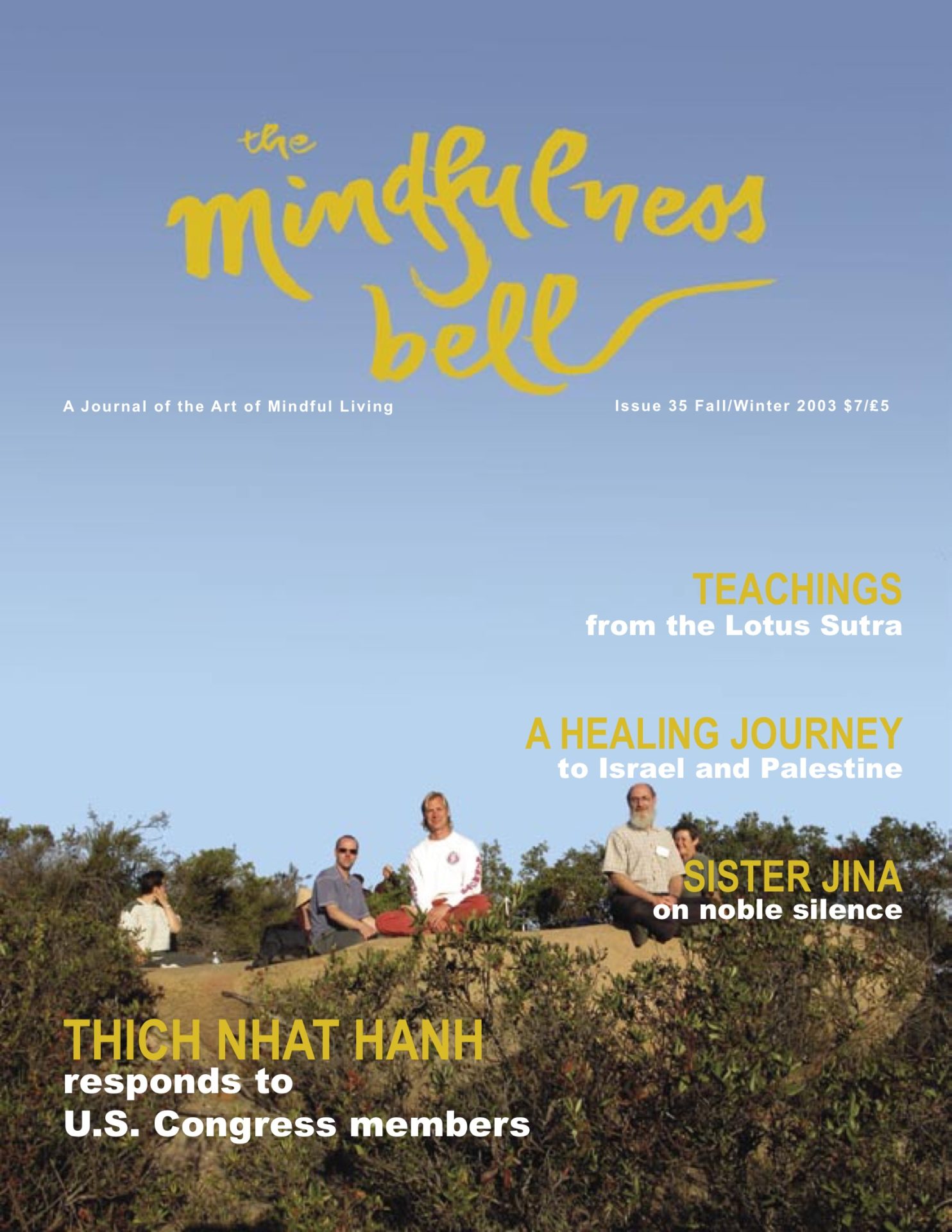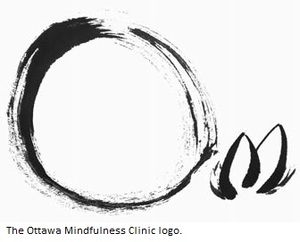
By Lynette Monteiro
Understanding the concepts of impermanence, non-self, and nirvana evaded me despite thee tomes I read and the lectures I attended. Then in 1998, I was diagnosed with fibromyalgia and in the subsequent years struggled with fatigue, pain, and frustration. Refusing to be defeated by this illness, I intensified my meditation practice, changed my eating habits, and took on a regimented exercise program. Despite the positive physical changes,

By Lynette Monteiro
Understanding the concepts of impermanence, non-self, and nirvana evaded me despite thee tomes I read and the lectures I attended. Then in 1998, I was diagnosed with fibromyalgia and in the subsequent years struggled with fatigue, pain, and frustration. Refusing to be defeated by this illness, I intensified my meditation practice, changed my eating habits, and took on a regimented exercise program. Despite the positive physical changes, emotionally I remained exhausted and I felt no closer to knowing how to apply the practice of Buddhism to my situation.
The way out began over a coffee at Starbucks. A physician friend cornered me with Jon Kabat-Zinn’s book, Full Catastrophe Living (2) and asked if I would start a clinic to treat our mutual patients using mindfulness skills. I laughed. With barely enough energy to get from one day to the next, attempting this was out of the question. However, I knew that my meditative and doctrinal practice in Buddhism was the stabilizing force in coping with my disorder. Studying the sutras and having a disciplined meditation schedule gave me continual insights to the nature of my mind and its role in managing my illness. I could see the potential benefits and that it would be a way of reaching so many who were suffering. But start a clinic, especially when I seemed to struggle with core concepts? I thought it impossible until I attended a retreat with Chan Huy. He watered the seeds of comprehension for me with his presentation of the thirteenth step of the Anapanasati Sutra: On the Full Awareness of Breathing bringing to my attention three primary tenets of practice: Practicing Continuously, Being in the Moment, Living in Joy.
Suddenly the clinic seemed possible. I became aware that what had been effective in managing my illness was not the physical schedules, the intellectual calisthenics, or the chase after experiences. What had helped me gain ease and composure in my suffering was living as best I could the concepts of impermanence, non-self, and nirvana. I held no assumptions that any one moment would be the same as another. I was not my illness, I found joy and happiness where I could. Symptoms ebbed and flowed as did mind and its mental formations but I somehow stayed steady.
In May 2003, my partner and I began the Mindfulness Based Symptom Management program, an eight-week course in skillful living modeled along the lines of the Canadian mindfulness-based program (3) at the Center for Addictions and Mental Health in Toronto, Canada. The patients who registered were suffering from depression, anxiety, pain from severe physical traumas, and work-related stress. Some were afraid of relapse into depression when they returned to work. Over eight weeks, we planned to teach these patient-practitioners sitting and walking meditation, an understanding of the four foundations of mindfulness, the techniques in the awareness of breathing, and the use of the Five Mindfulness Trainings as a guide to symptom management. They would be trained to examine their instincts to wrestle for control over their symptoms. This approach of no-action has been referred to as a paradigm shift from the medical model interventions that emphasize aggressive and often invasive interventions. The course aspirations and curriculum were daunting and ambitious, even more so because the canons of Buddhism had to be rendered into an acceptable secular form. However, we believed that anything less would not be powerful enough to transform their suffering.
We embarked on the program with an understanding that the facilitators and patients were equally practitioners. The tenets of the Five Mindfulness Trainings were listed and became a beacon when the work seemed tedious or not immediately relevant. The core of the course examined the body, emotions, sensations (mind), and thoughts (the most easily accessed and intellectually grasped object of mind) (4). In each class, we practiced the appropriate technique from the Anapanasati sutra (5). In the class dealing with emotions, we used the Theranamo and Bhadekkaratta sutras (Knowing the Better Way to Live Alone/An Auspicious Day (6)), as parables to encourage beneficial engagement with self, other, and the world. The glue that held the whole works together however was the primary tenets of practice– Practicing Continuously, Being in the Moment, Living in Joy.
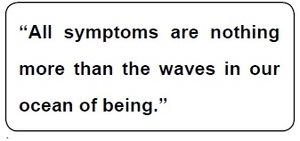
Practicing continuously
Without mindfulness skills, we become stuck in the illusion that symptoms are static and permanent, and therefore doom us to eternal suffering. Viewing the situation as singularly determined also results in thinking there is one magical intervention if we could “just do it.” When mindfulness is practiced continuously, we can look deeply into our symptoms and observe as they change in frequency, intensity, and duration. This is the gift of impermanence. It makes us available for many more possibilities and therefore many more opportunities to intervene in a suitable manner. Observing our level of fatigue we can recognize, for example, when jogging is less suitable than walking.
Practicing continuously means bringing awareness to all aspects of the system. We notice not just the segments of behaviors but the dynamic ebb and flow of all behaviors. It permits adjustment of our strategies as we attune ourselves to the impermanent nature of our experiences. When we are engaged fully in this practice, there is no way to “just do it” because there is no “it.” Continuous attention reveals nuances of change that alert us so we can adjust our actions, speech, and thoughts appropriately. It informs us when an intervention is suitable and beneficial; it informs us accurately of the specific signs in our body, which then allows selection of the beneficial and suitable level.
In the Clinic, patient-practitioners learn to adjust their body, speech, and mind to the ebb and flow of the breath. Using the body scan meditation technique, we set up an internal model of “observation, not indoctrination.” (7) That is, we learn to bring our attention to a part of our body, suspending the need to engage in action. We start with the toes, which always gets a smattering of giggles! The giggles turn to awe when we observe how hard it is to bring attention to the toes without twitching them automatically in response. We observe automatic behaviors and notice when we tune out, turn off, drop out of our daily lives. In the first two classes, we befriend our breathing and allow it to teach us the inevitability of change and the simplicity of adjusting to it. Because we breathe continuously, practicing continuously is no longer as imposing or tedious a task as it might have seemed initially.
Being in the present moment
The gift of non-self is the ability to discern the true nature of our suffering. Symptoms inter-are. They arise, endure, and dissolve from a complex interaction of the body, emotions, sensations, and thoughts. Arising in any single platform, they are empty containing neither intrinsic meaning nor power. However, when we apply our assumptions about an independent self, separation from others and the world, energy is imparted to our symptoms powering them up to debilitating levels. Muscle pain now becomes a harbinger of days in discomfort, even loss of income from lost wages. A limitation in physical activity now means loss of connection with family and friends.
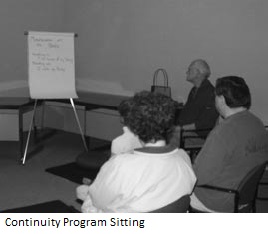
Grounding ourselves in the moment, we develop the skills to discern the origins of our pain with clarity and confidence. We develop an awareness of the arising conditions that result in our pain, our depression, and our fears. We can locate physical pain in the body, observe the thinking that escalates the meaning of the pain. Like teasing out the threads of a knotted ball of twine, we begin to separate the true nature of the symptom from the pain generated by the story-telling about the symptom. In the next four classes, we become firmly established in the foundation of mindfulness that is appropriate: in the body if the pain is physical, in the emotions if the pain is psychological, etc. Discernment among the foundations allows the interconnections with the other foundations to generate information, not escalation. As we learn to identify the energy that causes the pain, we can then take steps to find alternative sources of energy.
As patient-practitioners grasp these concepts, the defensive stance to illness changes. The belief that things have to be different from what they are in this moment dissolves. Each moment is just what it is, an occasion. The ghosts of the past lose their potency to enslave us and render us dysfunctional. The ghosts of the future cannot hold us hostage with anxiety, fear, and the threat of failed dreams. The power in our relationships with ourselves, others, and the world can only be realized in the present. At this point, a critical flaw in the organization of current psychotherapeutic interventions comes to the fore. Relapse is not something that we practice at some future date when our symptoms disappear. Every moment is an occasion to prevent relapse into previously unbeneficial behaviors, feelings, sensations, perceptions, and thoughts.
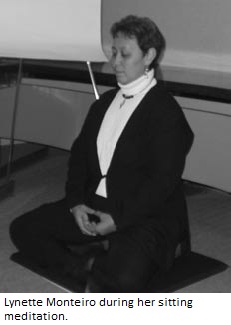
Living in joy
Joy is the realization that suffering is impermanent. Sometimes joy is retroactive, arising only when the craving and clinging to what is not has abated. While experiencing an attack of vertigo, I tried desperately to convince myself that the spinning room was only a mental formation. I recited: Not real, not real, not real. My mind remained resolutely unimpressed with my rhetoric (an object of mind) and joy was not present until my inner ear (body) calmed itself. Like a symphony, timing is everything. To expect joy in the middle of a flare of symptoms is to lose sight of the moment as it is. It throws us back to the illusions and delusions we created to avoid the reality of our suffering.
When symptoms recur despite our greatest efforts, we are given the opportunity to practice looking deeply into our assumptions. The arising of a symptom we thought was well-managed can touch on feelings of being a failure, activate models of helplessness, or even cause us to give up our practice. Looking deeply, we often find we have derived predictive equations relating our efforts to improvement in some linear fashion. Feeling energetic today becomes a promise that tomorrow will offer the same joy. Thrown into the future, we lose the moment of joy in the here and now.
Observing the breath, staying grounded in the body, emotions, sensations, and thoughts, patient-practitioners begin to experience the cessation of the craving to make things okay immediately. We recognize that symptoms dissolve and realize that awareness of impermanence enforces letting go. Symptoms become waves greeted, if not with ease, at least with composure and steadiness. With tools of mindfulness, we do know what to do. We acquire the secure knowledge that the symptoms are generated from the essence of who we are in the moment and dissipate as we alter our stance to them. In a single round of breathing in and out, we become evolving beings, intricately tied to self, others, and the world, and know comfort in that unity.
The Five Mindfulness Trainings
Throughout the course, the Five Mindfulness Trainings are used to give the skills a firm grounding in ethics and to provide deeper purpose for the practice. Viewing ourselves as worthy of respect, examining ways in which we generate delusions, setting psychological and physical boundaries, addressing ourselves with gentleness, and nourishing ourselves in a healthy manner become the modus operandi of creating skillful lives. As we become confident and stable in our practice, we find ourselves applying these skills in our interactions with others and our environment. In fact, interaction with all aspects of our environment is where the rubber meets the road. However, because suffering renders us somewhat narcissistic, we begin with applying the five trainings to ourselves.
Each foundational lesson is framed in the context of the five trainings. Behaving with respect to our body allows physical self-abusive cycles to be examined and broken. For the patient-practitioners suffering physical trauma this becomes a key to enter the realm of joy and acceptance. Rather than pushing past limits, they begin to accept and respect the body as it is.
Being generous to our body results in resting when needed, treating ourselves to days of silence and enjoyment of treasured activities. Depression and physical degenerative disorders respond well to this training. Rejuvenation becomes the form of continuous practice and symptoms no longer need to flare for attention.
Not exploiting our bodies psychologically or physically permits the building of safety in interactions with others. The target of this training is the anxiety generated from abusive relationships or lack of trust because of abuse. Recognizing and reducing exposure to toxic situations or relationships increases a sense that we are reliable in our assessments and consistent in our responses.
Speaking with kindness when referring to our body changes the sometimes hate-filled inner dialogue that in turn maintains our suffering. Lack of confidence, feelings of helplessness or low self-worth can be transformed through this training.

Altering the language alters the meaning we give to ourselves of who we are. As self-talk becomes supportive and honestly reflective of our situation, we develop trust and confidence that we can adjust to change.
Nourishing our bodies with beneficial foods and activities allows a sense of well-being. Being with persons who generate joy, feeling encouraged by others practicing healthy lifestyles, and exposing ourselves to a variety of perspectives break up the fixed patterns that signify most physical and psychological suffering. As we limit the input of common myths about being human, we begin to develop a stronger understanding of the reality of being just who we are.
The suffering arising from weak practice of mindfulness in the foundations of emotions, sensations, and objects of mind (in this case, thinking) respond equally well to this application. In fact, the remaining foundations are deeply contained in the foundation of the body and are interconnected profoundly with the body.
At the end of the eight weeks, we have all been irrevocably changed by our contact with each other. At the beginning of the course, the patient-practitioners were asked to list the things they wanted to change in themselves. Usually, the expectations revolved around “cure” or total cessation of physical and emotional symptoms. They want their suffering taken away when they enter7 treatment. Their perceptions of themselves as ones who suffer imply that the suffering means they are flawed and damaged by and because of their symptoms. So, at the start of the course, the craving is to be “normal” by which they mean “without suffering”. When asked if they have changed in ways they had listed eight weeks before, most patient-practitioners say it doesn’t matter anymore. Those expectations written fifty-six days ago are examined and deemed unrealistic, irrelevant, or—best of all—where there was no change, acceptable just as they are. Expectations transform into aspirations. Symptoms are now moments of education in developing skillful means. Self is now a product of an interaction of the four platforms with the moving moment and mindfulness is the mechanism to steady the interaction.
Continuity
Impermanence, non-self, and nirvana reveal themselves in each moment. By practicing continuously, we are able to stay grounded in each moment. Observing the breath, we move through the four foundations of body, emotions, mind, and objects of mind. Skillful means grow as we develop clear comprehension of what is beneficial and suitable action. Understanding the true nature of our illness grows further as we experience being firmly in our physical and psychological domain, cutting through the illusions of what it is not. All symptoms are nothing more than the waves in our ocean of being. In the moments that our practice is strong and stable, we can allow the symptoms of our illnesses to penetrate us as great teachers do and ultimately let them dissipate as waves in the ocean.
Lynette Monteiro, True Wonderful Fulfillment, practices with Sanghas in Ottawa and Montreal, Canada. She is a psychologist in private practice, and Director of the Ottawa Mindfulness Clinic. She bows to teachers Chan Huy and True Body of Wisdom for inspiring the Clinic and assisting in the preparation of this article. Photography by Lynette Monteiro.
1 Impermanence, non-self, and nirvana are called the “Three Dharma Seals.” A teaching offered by the Buddha is considered to be authentic if it has these three characteristics. The awareness of impermanence helps us to see that all things are subject to change. Nothing in the universe is a fixed, unchanging entity. Secondly, the awareness of non-self shows us that all things are without a separate self; everything inter-is with everything else. Thirdly, all things have their ultimate nature, their nature of nirvana, meaning the extinction of all notions, ideas, and concepts concerning reality. For a more thorough explanation of the Three Dharma Seals see Thich Nhat Hanh, The Heart of the Buddha’s Teachings (Berkeley: Parallax Press, 1998).
2 Kabat-Zinn, J. Full Catastrophe Living (Dell Publishing, 1990)
3 Segal, Z., M. Williams, & J. Teasdale, Mindfulness-based Cognitive Therapy for Depression (Guilford Press, 2002)
4 Thich Nhat Hanh, Transformation and Healing: Sutra on the Four Establishments of Mindfulness (Berkeley: Parallax Press 1990) and the following texts were used by the facilitators to organize the course content
5 Thich Nhat Hanh, Breathe! You are Alive: the Sutra on the Full Awareness of Breathing (Berkeley: Parallax Press, 1990)
6 Thich Nhat Hanh, Our Appointment with Life: The Buddha’s Teaching on Living in the Present (Berkeley: Parallax Press, 1990)
7 Thich Nhat Hanh, Transformation and Healing, p 134

